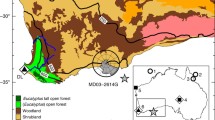Abstract
There are five major hypotheses to explain the apparently synchronous, widespread, spectacular, specific, and sudden elm decline in north-west Europe — climatic change, soil change, competition, human impact, and pathogenic attack. The first four hypotheses predict slow declines (ca. 50–250 years), whereas the pathogen hypothesis predicts a rapid decline (ca. 10–20 years). Pollen analyses of annually laminated sediments from Diss Mere across the elm fall show that the Ulmus decline occurred within 7 years but that there was human impact in the surrounding forest for at least 160 years, including local cereal cultivation for at least 120 years, prior to the elm fall. At the time of the elm decline, there is no evidence for particularly warm or cold seasons or for any additional human interference. The magnitude and rate of the elm pollen decline are consistent with O. Rackham's hypothesis of a pathogenic attack taking place within woodland where the elm trees were already damaged as a result of human activity.
Similar content being viewed by others
References
Brunskill GJ (1969) Fayette Green Lake, New York. II. Precipitation and sedimentation of calcite in a meromictic lake with laminated sediments. Limnol Oceanogr 14:830–847
Edwards KJ, MacDonald GM (1991) Holocene palynology: II. Human influence and vegetation change. Prog Phys Geogr 15:364–391
Fredskild B (1978) The creation of open landscape. Our open countryside (in Danish). Dan Naturfredningsforen Årksskr 1978:9–15
Frenzel B (1966) Climatic change in the Atlantic/Sub-boreal transition in the Northern Hemisphere: botanical evidence. In: Sawyer JS (ed) World climate from 8000 to 0 B.C. Royal Meteorological Society, London, pp 89–123
Fritz SC (1989) Lake development and limnological response to prehistoric and historic land-use in Diss, Norfolk, England. J Ecol 77:182–202
Fægri K (1944) On the introduction of agriculture in western Norway. Geol Fören Förhandl Stock 66:449–462
Girling MA (1988) The bark beetle Scolytus scolytus (Fabricius) and the possible role of elm disease in the early Neolithic. In: Jones M (ed) Archaeology and the flora of the British Isles. Oxford University Committee for Archaeology Monograph 4:34–38
Göransson H (1986) Man and the forests of nemoral broad-leafed trees during the Stone Age. Striae 24:143–152
Groenman-van Waateringe W (1983) The early agricultural utilization of the Irish landscape: the last word on the elm decline? In: Reeves-Smyth T, Hammond F (eds) Landscape archaeology in Ireland. British Archaeological Reports, British Series 116:217–232
Guyan WH (1955) Das jungsteinzeitliche Moordorf von Thayngen-Weier. In: Guyan WH (ed) Das Pfahlbauproblem. Birkhauser, Basle, pp 223–274
Hengeveld R (1990) Dynamic biogeography. Cambridge University Press, Cambridge
Huntley B, Birks HJB (1983) An atlas of past and present pollen maps for Europe: 0–13000 years ago. Cambridge University Press, Cambridge
Iversen J (1941) Land occupation in Danmark's Stone Age. Dan Geol Unders, Series II, 66:1–68
Iversen J (1960) Problems of the early post-glacial forest development in Denmark. Dan Geol Unders, Series IV, 4 (3):1–32
Iversen J (1973) The development of Denmark's nature since the last glacial. Dan Geol Unders, Series V, 7-C:1–126
Janssen CR (1973) Local and regional pollen deposition. In: Birks HJB, West RG (eds) Quaternary plant ecology. Blackwell, Oxford, pp 31–42
Nilsson T (1948) On the application of the Scanian post-glacial zone system to Danish pollen-diagrams. K Dan Vidensk Selsk Biol Skr V (5):1–53
Nilsson T (1961) Ein neues Standardpollendiagramm aus Bjärsjoholmssjön in Schonen. Lunds Univ Årsskr NF 56 (18):1–34
Peglar SM (1993a) The development of the cultural landscape around Diss Mere, Norfolk, U.K., over the past 7000 years. Rev Palaeobot Palynol 76:1–47
Peglar SM (1993b) The mid-Holocene Ulmus decline at Diss Mere, Norfolk, U.K.: a year-by-year pollen stratigraphy from annual laminations. Holocene 3:1–13
Peglar SM, Fritz SC, Alapieti T, Saarnisto M, Birks HJB (1984) Composition and formation of laminated sediments in Diss Mere, Norfolk, England. Boreas 13:13–28
Peglar SM, Fritz SC, Birks HJB (1989) Vegetation and land-use history at Diss, Norfolk, U.K. J Ecol 77:203–222
Rackham O (1980) Ancient woodland: its history, vegetation and uses in England. Edward Arnold, London
Ralska-Jasiewczowa M, Geel B van (1992) Early human disturbance of the natural environment recorded in annually laminated sediments at Lake Gosciaz, central Poland. Veget Hist Archaeobot 1:33–42
Rasmussen P (1989) Leaf-foddering of livestock in the Neolithic: archaeobotanical evidence from Weier, Switzerland. J Danish Archaeol 8:51–71
Smith AG (1961) The AtlanticÄSub-Boreal transition. Proc Linn Soc London 172:38–49
Smith AG (1970) The influence of Mesolithic and Neolithic man on British vegetation: a discussion. In: Walker D, West RG (eds) Studies of the vegetational history of the British Isles. Cambridge University Press, London, pp 81–96
Smith AG (1981) The Neolithic. In: Simmons IG, Tooley MJ (eds) The environment in British Prehistory. Duckworth, London, pp 125–209
Sturlodottir SA, Turner J (1985) The elm decline at Pawlaw mire: an anthropogenic interpretation. New Phytol 99:323–329
Ten Hove HA (1968) The Ulmus fall at the transition Atlanticum-Subboreal in pollen diagrams. Palaeogeogr Palaeoclimatol Palaeoecol 5:359–369
Troels-Smith J (1955) Pollenanalytische Untersuchungen zu einigen schweizerischen Pfahlbauproblemen. In: Guyan WH (ed) Das Pfahlbauproblem. Birkhauser, Basle, pp 11–58
Troels-Smith J (1960) Ivy, mistletoe and elm: climatic indicatorsfodder plants. Dan Geol Unders Series IV 4(4):1–32
Watts WA (1961) Post-Atlantic forests in Ireland. Proc Linn Soc London 172:33–38
Author information
Authors and Affiliations
Additional information
A contribution to the 8th IPC, Aix-en-Provence, Sept. 1992
Rights and permissions
About this article
Cite this article
Peglar, S.M., Birks, H.J.B. The mid-Holocene Ulmus fall at Diss Mere, South-East England — disease and human impact?. Veget Hist Archaebot 2, 61–68 (1993). https://doi.org/10.1007/BF00202183
Received:
Accepted:
Issue Date:
DOI: https://doi.org/10.1007/BF00202183




